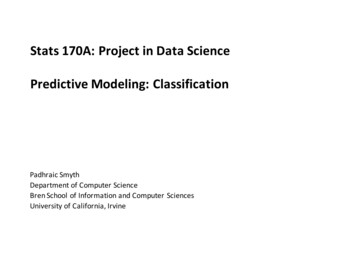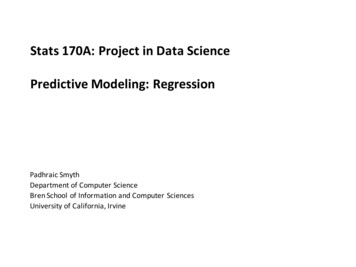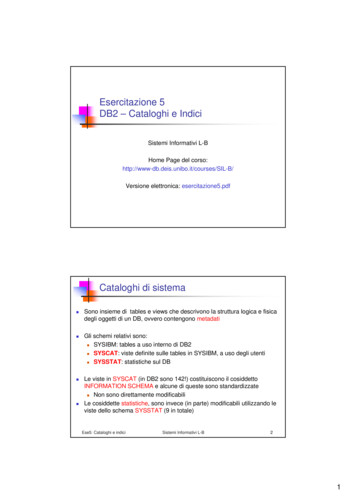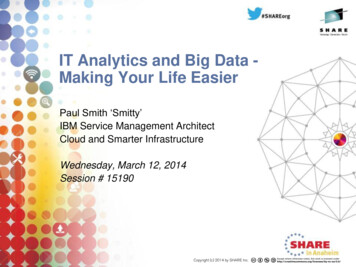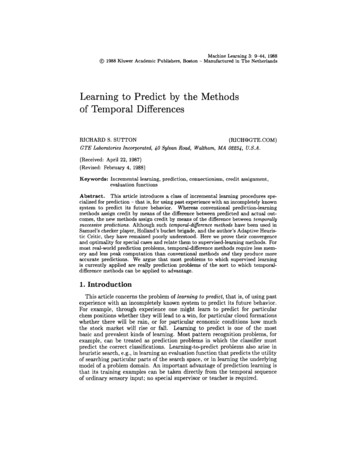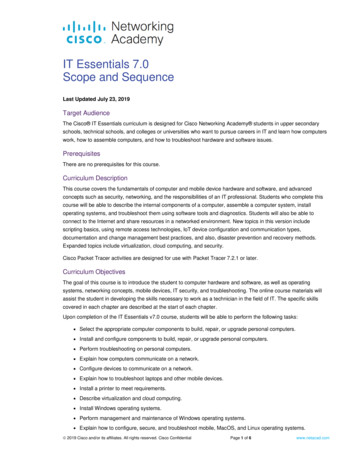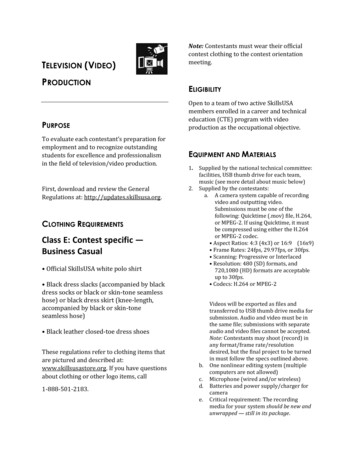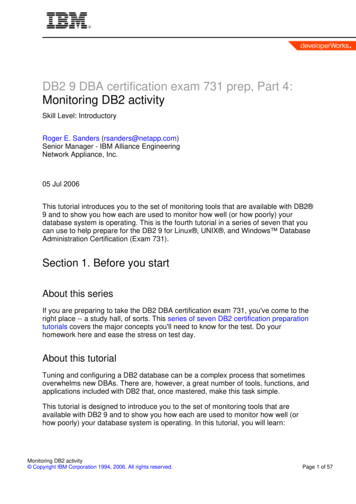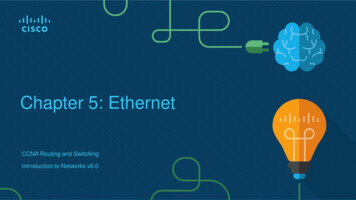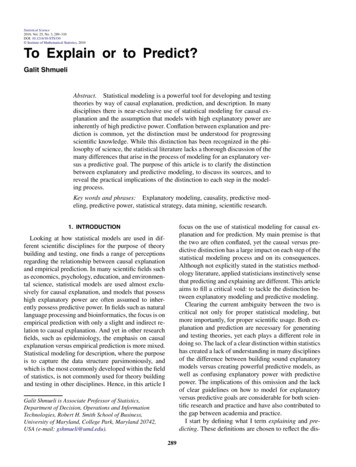
Transcription
Statistical Science2010, Vol. 25, No. 3, 289–310DOI: 10.1214/10-STS330 Institute of Mathematical Statistics, 2010To Explain or to Predict?Galit ShmueliAbstract. Statistical modeling is a powerful tool for developing and testingtheories by way of causal explanation, prediction, and description. In manydisciplines there is near-exclusive use of statistical modeling for causal explanation and the assumption that models with high explanatory power areinherently of high predictive power. Conflation between explanation and prediction is common, yet the distinction must be understood for progressingscientific knowledge. While this distinction has been recognized in the philosophy of science, the statistical literature lacks a thorough discussion of themany differences that arise in the process of modeling for an explanatory versus a predictive goal. The purpose of this article is to clarify the distinctionbetween explanatory and predictive modeling, to discuss its sources, and toreveal the practical implications of the distinction to each step in the modeling process.Key words and phrases: Explanatory modeling, causality, predictive modeling, predictive power, statistical strategy, data mining, scientific research.focus on the use of statistical modeling for causal explanation and for prediction. My main premise is thatthe two are often conflated, yet the causal versus predictive distinction has a large impact on each step of thestatistical modeling process and on its consequences.Although not explicitly stated in the statistics methodology literature, applied statisticians instinctively sensethat predicting and explaining are different. This articleaims to fill a critical void: to tackle the distinction between explanatory modeling and predictive modeling.Clearing the current ambiguity between the two iscritical not only for proper statistical modeling, butmore importantly, for proper scientific usage. Both explanation and prediction are necessary for generatingand testing theories, yet each plays a different role indoing so. The lack of a clear distinction within statisticshas created a lack of understanding in many disciplinesof the difference between building sound explanatorymodels versus creating powerful predictive models, aswell as confusing explanatory power with predictivepower. The implications of this omission and the lackof clear guidelines on how to model for explanatoryversus predictive goals are considerable for both scientific research and practice and have also contributed tothe gap between academia and practice.I start by defining what I term explaining and predicting. These definitions are chosen to reflect the dis-1. INTRODUCTIONLooking at how statistical models are used in different scientific disciplines for the purpose of theorybuilding and testing, one finds a range of perceptionsregarding the relationship between causal explanationand empirical prediction. In many scientific fields suchas economics, psychology, education, and environmental science, statistical models are used almost exclusively for causal explanation, and models that possesshigh explanatory power are often assumed to inherently possess predictive power. In fields such as naturallanguage processing and bioinformatics, the focus is onempirical prediction with only a slight and indirect relation to causal explanation. And yet in other researchfields, such as epidemiology, the emphasis on causalexplanation versus empirical prediction is more mixed.Statistical modeling for description, where the purposeis to capture the data structure parsimoniously, andwhich is the most commonly developed within the fieldof statistics, is not commonly used for theory buildingand testing in other disciplines. Hence, in this article IGalit Shmueli is Associate Professor of Statistics,Department of Decision, Operations and InformationTechnologies, Robert H. Smith School of Business,University of Maryland, College Park, Maryland 20742,USA (e-mail: gshmueli@umd.edu).289
290G. SHMUELItinct scientific goals that they are aimed at: causal explanation and empirical prediction, respectively. Explanatory modeling and predictive modeling reflect theprocess of using data and statistical (or data mining)methods for explaining or predicting, respectively. Theterm modeling is intentionally chosen over models tohighlight the entire process involved, from goal definition, study design, and data collection to scientific use.1.1 Explanatory ModelingIn many scientific fields, and especially the socialsciences, statistical methods are used nearly exclusively for testing causal theory. Given a causal theoretical model, statistical models are applied to data inorder to test causal hypotheses. In such models, a setof underlying factors that are measured by variables Xare assumed to cause an underlying effect, measuredby variable Y . Based on collaborative work with socialscientists and economists, on an examination of someof their literature, and on conversations with a diversegroup of researchers, I conjecture that, whether statisticians like it or not, the type of statistical models usedfor testing causal hypotheses in the social sciences arealmost always association-based models applied to observational data. Regression models are the most common example. The justification for this practice is thatthe theory itself provides the causality. In other words,the role of the theory is very strong and the relianceon data and statistical modeling are strictly through thelens of the theoretical model. The theory–data relationship varies in different fields. While the social sciencesare very theory-heavy, in areas such as bioinformatics and natural language processing the emphasis ona causal theory is much weaker. Hence, given this reality, I define explaining as causal explanation and explanatory modeling as the use of statistical models fortesting causal explanations.F IG . 1.To illustrate how explanatory modeling is typicallydone, I describe the structure of a typical article in ahighly regarded journal in the field of Information Systems (IS). Researchers in the field of IS usually havetraining in economics and/or the behavioral sciences.The structure of articles reflects the way empirical research is conducted in IS and related fields.The example used is an article by Gefen, Karahannaand Straub (2003), which studies technology acceptance. The article starts with a presentation of the prevailing relevant theory(ies):Online purchase intensions should be explained in part by the technology acceptance model (TAM). This theoretical modelis at present a preeminent theory of technology acceptance in IS.The authors then proceed to state multiple causal hypotheses (denoted H1 , H2 , . . . in Figure 1, right panel),justifying the merits for each hypothesis and grounding it in theory. The research hypotheses are given interms of theoretical constructs rather than measurablevariables. Unlike measurable variables, constructs areabstractions that “describe a phenomenon of theoretical interest” (Edwards and Bagozzi, 2000) and can beobservable or unobservable. Examples of constructs inthis article are trust, perceived usefulness (PU), andperceived ease of use (PEOU). Examples of constructsused in other fields include anger, poverty, well-being,and odor. The hypotheses section will often include acausal diagram illustrating the hypothesized causal relationship between the constructs (see Figure 1, leftpanel). The next step is construct operationalization,where a bridge is built between theoretical constructsand observable measurements, using previous literature and theoretical justification. Only after the theoretical component is completed, and measurements arejustified and defined, do researchers proceed to the nextCausal diagram (left) and partial list of stated hypotheses (right) from Gefen, Karahanna and Straub (2003).
TO EXPLAIN OR TO PREDICT?step where data and statistical modeling are introducedalongside the statistical hypotheses, which are operationalized from the research hypotheses. Statistical inference will lead to “statistical conclusions” in terms ofeffect sizes and statistical significance in relation to thecausal hypotheses. Finally, the statistical conclusionsare converted into research conclusions, often accompanied by policy recommendations.In summary, explanatory modeling refers here tothe application of statistical models to data for testing causal hypotheses about theoretical constructs.Whereas “proper” statistical methodology for testingcausality exists, such as designed experiments or specialized causal inference methods for observationaldata [e.g., causal diagrams (Pearl, 1995), discoveryalgorithms (Spirtes, Glymour and Scheines, 2000),probability trees (Shafer, 1996), and propensity scores(Rosenbaum and Rubin, 1983; Rubin, 1997)], in practice association-based statistical models, applied to observational data, are most commonly used for that purpose.1.2 Predictive ModelingI define predictive modeling as the process of applying a statistical model or data mining algorithm to datafor the purpose of predicting new or future observations. In particular, I focus on nonstochastic prediction(Geisser, 1993, page 31), where the goal is to predictthe output value (Y ) for new observations given theirinput values (X). This definition also includes temporalforecasting, where observations until time t (the input)are used to forecast future values at time t k, k 0(the output). Predictions include point or interval predictions, prediction regions, predictive distributions, orrankings of new observations. Predictive model is anymethod that produces predictions, regardless of its underlying approach: Bayesian or frequentist, parametricor nonparametric, data mining algorithm or statisticalmodel, etc.1.3 Descriptive ModelingAlthough not the focus of this article, a third type ofmodeling, which is the most commonly used and developed by statisticians, is descriptive modeling. Thistype of modeling is aimed at summarizing or representing the data structure in a compact manner. Unlike explanatory modeling, in descriptive modeling thereliance on an underlying causal theory is absent or incorporated in a less formal way. Also, the focus is at themeasurable level rather than at the construct level. Unlike predictive modeling, descriptive modeling is not291aimed at prediction. Fitting a regression model can bedescriptive if it is used for capturing the association between the dependent and independent variables ratherthan for causal inference or for prediction. We mentionthis type of modeling to avoid confusion with causalexplanatory and predictive modeling, and also to highlight the different approaches of statisticians and nonstatisticians.1.4 The Scientific Value of Predictive ModelingAlthough explanatory modeling is commonly usedfor theory building and testing, predictive modeling isnearly absent in many scientific fields as a tool for developing theory. One possible reason is the statisticaltraining of nonstatistician researchers. A look at manyintroductory statistics textbooks reveals very little inthe way of prediction. Another reason is that predictionis often considered unscientific. Berk (2008) wrote, “Inthe social sciences, for example, one either did causalmodeling econometric style or largely gave up quantitative work.” From conversations with colleagues invarious disciplines it appears that predictive modelingis often valued for its applied utility, yet is discarded forscientific purposes such as theory building or testing.Shmueli and Koppius (2010) illustrated the lack of predictive modeling in the field of IS. Searching the 1072papers published in the two top-rated journals Information Systems Research and MIS Quarterly between1990 and 2006, they found only 52 empirical paperswith predictive claims, of which only seven carried outproper predictive modeling or testing.Even among academic statisticians, there appears tobe a divide between those who value prediction as themain purpose of statistical modeling and those who seeit as unacademic. Examples of statisticians who emphasize predictive methodology include Akaike (“Thepredictive point of view is a prototypical point of viewto explain the basic activity of statistical analysis” inFindley and Parzen, 1998), Deming (“The only useful function of a statistician is to make predictions”in Wallis, 1980), Geisser (“The prediction of observables or potential observables is of much greater relevance than the estimate of what are often artificialconstructs-parameters,” Geisser, 1975), Aitchison andDunsmore (“prediction analysis. . . is surely at the heartof many statistical applications,” Aitchison and Dunsmore, 1975) and Friedman (“One of the most common and important uses for data is prediction,” Friedman, 1997). Examples of those who see it as unacademic are Kendall and Stuart (“The Science of Statisticsdeals with the properties of populations. In considering
292G. SHMUELIa population of men we are not interested, statisticallyspeaking, in whether some particular individual hasbrown eyes or is a forger, but rather in how many of theindividuals have brown eyes or are forgers,” Kendalland Stuart, 1977) and more recently Parzen (“The twogoals in analyzing data. . . I prefer to describe as “management” and “science.” Management seeks profit. . .Science seeks truth,” Parzen, 2001). In economics thereis a similar disagreement regarding “whether prediction per se is a legitimate objective of economic science, and also whether observed data should be usedonly to shed light on existing theories or also for thepurpose of hypothesis seeking in order to develop newtheories” (Feelders, 2002).Before proceeding with the discrimination betweenexplanatory and predictive modeling, it is important toestablish prediction as a necessary scientific endeavorbeyond utility, for the purpose of developing and testing theories. Predictive modeling and predictive testingserve several necessary scientific functions:1. Newly available large and rich datasets often contain complex relationships and patterns that are hardto hypothesize, especially given theories that exclude newly measurable concepts. Using predictive modeling in such contexts can help uncoverpotential new causal mechanisms and lead to thegeneration of new hypotheses. See, for example,the discussion between Gurbaxani and Mendelson(1990, 1994) and Collopy, Adya and Armstrong(1994).2. The development of new theory often goes hand inhand with the development of new measures (VanMaanen, Sorensen and Mitchell, 2007). Predictivemodeling can be used to discover new measures aswell as to compare different operationalizations ofconstructs and different measurement instruments.3. By capturing underlying complex patterns and relationships, predictive modeling can suggest improvements to existing explanatory models.4. Scientific development requires empirically rigorous and relevant research. Predictive modeling enables assessing the distance between theory andpractice, thereby serving as a “reality check” tothe relevance of theories.1 While explanatory powerprovides information about the strength of an underlying causal relationship, it does not imply its predictive power.1 Predictive models are advantageous in terms of negative em-piricism: a model either predicts accurately or it does not, and thiscan be observed. In contrast, explanatory models can never be confirmed and are harder to contradict.5. Predictive power assessment offers a straightforward way to compare competing theories by examining the predictive power of their respective explanatory models.6. Predictive modeling plays an important role inquantifying the level of predictability of measurablephenomena by creating benchmarks of predictiveaccuracy (Ehrenberg and Bound, 1993). Knowledgeof un-predictability is a fundamental component ofscientific knowledge (see, e.g., Taleb, 2007). Because predictive models tend to have higher predictive accuracy than explanatory statistical models,they can give an indication of the potential levelof predictability. A very low predictability levelcan lead to the development of new measures, newcollected data, and new empirical approaches. Anexplanatory model that is close to the predictivebenchmark may suggest that our understanding ofthat phenomenon can only be increased marginally.On the other hand, an explanatory model that is veryfar from the predictive benchmark would imply thatthere are substantial practical and theoretical gainsto be had from further scientific development.For a related, more detailed discussion of the valueof prediction to scientific theory development see thework of Shmueli and Koppius (2010).1.5 Explaining and Predicting Are DifferentIn the philosophy of science, it has long been debated whether explaining and predicting are one ordistinct. The conflation of explanation and prediction has its roots in philosophy of science literature, particularly the influential hypothetico-deductivemodel (Hempel and Oppenheim, 1948), which explicitly equated prediction and explanation. However, aslater became clear, the type of uncertainty associatedwith explanation is of a different nature than that associated with prediction (Helmer and Rescher, 1959).This difference highlighted the need for developingmodels geared specifically toward dealing with predicting future events and trends such as the Delphimethod (Dalkey and Helmer, 1963). The distinctionbetween the two concepts has been further elaborated(Forster and Sober, 1994; Forster, 2002; Sober, 2002;Hitchcock and Sober, 2004; Dowe, Gardner and Oppy,2007). In his book Theory Building, Dubin (1969,page 9) wrote:Theories of social and human behavior address themselves to two distinct goals of
293TO EXPLAIN OR TO PREDICT?science: (1) prediction and (2) understanding. It will be argued that these are separategoals [. . . ] I will not, however, conclude thatthey are either inconsistent or incompatible.Herbert Simon distinguished between “basic science”and “applied science” (Simon, 2001), a distinction similar to explaining versus predicting. According to Simon, basic science is aimed at knowing (“to describethe world”) and understanding (“to provide explanations of these phenomena”). In contrast, in applied science, “Laws connecting sets of variables allow inferences or predictions to be made from known values ofsome of the variables to unknown values of other variables.”Why should there be a difference between explainingand predicting? The answer lies in the fact that measurable data are not accurate representations of their underlying constructs. The operationalization of theoriesand constructs into statistical models and measurabledata creates a disparity between the ability to explainphenomena at the conceptual level and the ability togenerate predictions at the measurable level.To convey this disparity more formally, consider atheory postulating that construct X causes constructY , via the function F , such that Y F (X ). F is often represented by a path model, a set of qualitativestatements, a plot (e.g., a supply and demand plot), ormathematical formulas. Measurable variables X and Yare operationalizations of X and Y , respectively. Theoperationalization of F into a statistical model f , suchas E(Y ) f (X), is done by considering F in light ofthe study design (e.g., numerical or categorical Y ; hierarchical or flat design; time series or cross-sectional;complete or censored data) and practical considerations such as standards in the discipline. Because Fis usually not sufficiently detailed to lead to a single f ,often a set of f models is considered. Feelders (2002)described this process in the field of economics. In thepredictive context, we consider only X, Y and f .The disparity arises because the goal in explanatorymodeling is to match f and F as closely as possiblefor the statistical inference to apply to the theoreticalhypotheses. The data X, Y are tools for estimating f ,which in turn is used for testing the causal hypotheses.In contrast, in predictive modeling the entities of interest are X and Y , and the function f is used as a tool forgenerating good predictions of new Y values. In fact,we will see that even if the underlying causal relationship is indeed Y F (X ), a function other than fˆ(X)and data other than X might be preferable for prediction.The disparity manifests itself in different ways. Fourmajor aspects are:Causation–Association: In explanatory modeling frepresents an underlying causal function, and X isassumed to cause Y . In predictive modeling f captures the association between X and Y .Theory–Data: In explanatory modeling, f is carefully constructed based on F in a fashion that supports interpreting the estimated relationship betweenX and Y and testing the causal hypotheses. In predictive modeling, f is often constructed from the data.Direct interpretability in terms of the relationship between X and Y is not required, although sometimestransparency of f is desirable.Retrospective–Prospective: Predictive modeling isforward-looking, in that f is constructed for predicting new observations. In contrast, explanatorymodeling is retrospective, in that f is used to test analready existing set of hypotheses.Bias–Variance: The expected prediction error for anew observation with value x, using a quadratic lossfunction,2 is given by Hastie, Tibshirani and Friedman (2009, page 223)EPE E{Y fˆ(x)}2(1) E{Y f (x)}2 {E(fˆ(x)) f (x)}2 E{fˆ(x) E(fˆ(x))}2 Var(Y ) Bias2 Var(fˆ(x)).Bias is the result of misspecifying the statisticalmodel f . Estimation variance (the third term) is theresult of using a sample to estimate f . The first termis the error that results even if the model is correctlyspecified and accurately estimated. The above decomposition reveals a source of the difference between explanatory and predictive modeling: In explanatory modeling the focus is on minimizing biasto obtain the most accurate representation of theunderlying theory. In contrast, predictive modelingseeks to minimize the combination of bias and estimation variance, occasionally sacrificing theoretical accuracy for improved empirical precision. Thispoint is illustrated in the Appendix, showing that the“wrong” model can sometimes predict better thanthe correct one.2 For a binary Y , various 0–1 loss functions have been suggestedin place of the quadratic loss function (Domingos, 2000).
294G. SHMUELIThe four aspects impact every step of the modelingprocess, such that the resulting f is markedly differentin the explanatory and predictive contexts, as will beshown in Section 2.1.6 A Void in the Statistics LiteratureThe philosophical explaining/predicting debate hasnot been directly translated into statistical language interms of the practical aspects of the entire statisticalmodeling process.A search of the statistics literature for discussion ofexplaining versus predicting reveals a lively discussionin the context of model selection, and in particular, thederivation and evaluation of model selection criteria. Inthis context, Konishi and Kitagawa (2007) wrote:There may be no significant difference between the point of view of inferring the truestructure and that of making a prediction ifan infinitely large quantity of data is available or if the data are noiseless. However,in modeling based on a finite quantity ofreal data, there is a significant gap betweenthese two points of view, because an optimalmodel for prediction purposes may be different from one obtained by estimating the‘true model.’The literature on this topic is vast, and we do not intendto cover it here, although we discuss the major pointsin Section 2.6.The focus on prediction in the field of machine learning and by statisticians such as Geisser, Aitchison andDunsmore, Breiman and Friedman, has highlighted aspects of predictive modeling that are relevant to the explanatory/prediction distinction, although they do notdirectly contrast explanatory and predictive modeling.3The prediction literature raises the importance of evaluating predictive power using holdout data, and theusefulness of algorithmic methods (Breiman, 2001b).The predictive focus has also led to the developmentof inference tools that generate predictive distributions.Geisser (1993) introduced “predictive inference” anddeveloped it mainly in a Bayesian context. “Predictive likelihood” (see Bjornstad, 1990) is a likelihoodbased approach to predictive inference, and Dawid’sprequential theory (Dawid, 1984) investigates inference concepts in terms of predictability. Finally, the3 Geisser distinguished between “[statistical] parameters” and“observables” in terms of the objects of interest. His distinctionis closely related, but somewhat different from our distinction between theoretical constructs and measurements.bias–variance aspect has been pivotal in data miningfor understanding the predictive performance of different algorithms and for designing new ones.Another area in statistics and econometrics that focuses on prediction is time series. Methods have beendeveloped specifically for testing the predictability ofa series [e.g., random walk tests or the concept ofGranger causality (Granger, 1969)], and evaluatingpredictability by examining performance on holdoutdata. The time series literature in statistics is dominatedby extrapolation models such as ARIMA-type modelsand exponential smoothing methods, which are suitable for prediction and description, but not for causalexplanation. Causal models for time series are commonin econometrics (e.g., Song and Witt, 2000), where anunderlying causal theory links constructs, which leadto operationalized variables, as in the cross-sectionalcase. Yet, to the best of my knowledge, there is nodiscussion in the statistics time series literature regarding the distinction between predictive and explanatorymodeling, aside from the debate in economics regarding the scientific value of prediction.To conclude, the explanatory/predictive modelingdistinction has been discussed directly in the model selection context, but not in the larger context. Areas thatfocus on developing predictive modeling such as machine learning and statistical time series, and “predictivists” such as Geisser, have considered prediction as aseparate issue, and have not discussed its principal andpractical distinction from causal explanation in termsof developing and testing theory. The goal of this article is therefore to examine the explanatory versus predictive debate from a statistical perspective, considering how modeling is used by nonstatistician scientistsfor theory development.The remainder of the article is organized as follows. In Section 2, I consider each step in the modeling process in terms of the four aspects of the predictive/explanatory modeling distinction: causation–association, theory–data, retrospective–prospectiveand bias–variance. Section 3 illustrates some of thesedifferences via two examples. A discussion of the implications of the predict/explain conflation, conclusions, and recommendations are given in Section 4.2. TWO MODELING PATHSIn the following I examine the process of statistical modeling through the explain/predict lens, fromgoal definition to model use and reporting. For clarity, I broke down the process into a generic set of steps,
TO EXPLAIN OR TO PREDICT?F IG . 2.Steps in the statistical modeling process.as depicted in Figure 2. In each step I point out differences in the choice of methods, criteria, data, and information to consider when the goal is predictive versusexplanatory. I also briefly describe the related statistics literature. The conceptual and practical differencesinvariably lead to a difference between a final explanatory model and a predictive one, even though they mayuse the same initial data. Thus, a priori determinationof the main study goal as either explanatory or predictive4 is essential to conducting adequate modeling.The discussion in this section assumes that the main research goal has been determined as either explanatoryor predictive.2.1 Study Design and Data CollectionEven at the early stages of study design and datacollection, issues of what and how much data to collect, according to what design, and which collectioninstrument to use are considered differently for prediction versus explanation. Consider sample size. In explanatory modeling, where the goal is to estimate thetheory-based f with adequate precision and to use itfor inference, statistical power is the main consideration. Reducing bias also requires sufficient data formodel specification testing. Beyond a certain amountof data, however, extra precision is negligible for purposes of inference. In contrast, in predictive modeling,f itself is often determined from the data, thereby requiring a larger sample for achieving lower bias andvariance. In addition, more data are needed for creatingholdout datasets (see Section 2.2). Finally, predictingnew individual observations accurately, in a prospective manner, requires more data than retrospective inference regarding population-level parameters, due tothe extra uncertainty.A second design issue is sampling scheme. Forinstance, in the context of hierarchical data (e.g.,sampling students within schools) Afshartous and deLeeuw (2005) noted, “Although there exists an extensive literature on estimation issues in multilevel models, the same cannot be said with respect to prediction.”4 The main study goal can also be descriptive.295Examining issues of sample size, sample allocation,and multilevel modeling for the purpose of “predictinga future observable y j in the J th group of a hierarchial dataset,” they found that allocation for estimationversus prediction should be different: “an increase ingroup size n is often more beneficial with respect toprediction than an increase in the number of groupsJ . . . [whereas]
explanatory and predictive modeling, and also to high-light the different approaches of statisticians and non-statisticians. 1.4 The Scientific Value of Predictive Modeling Although explanatory modeling is commonly used for theory building and testing, predictive modeling is nearly absent in many scientific fields as a tool for de-veloping .

